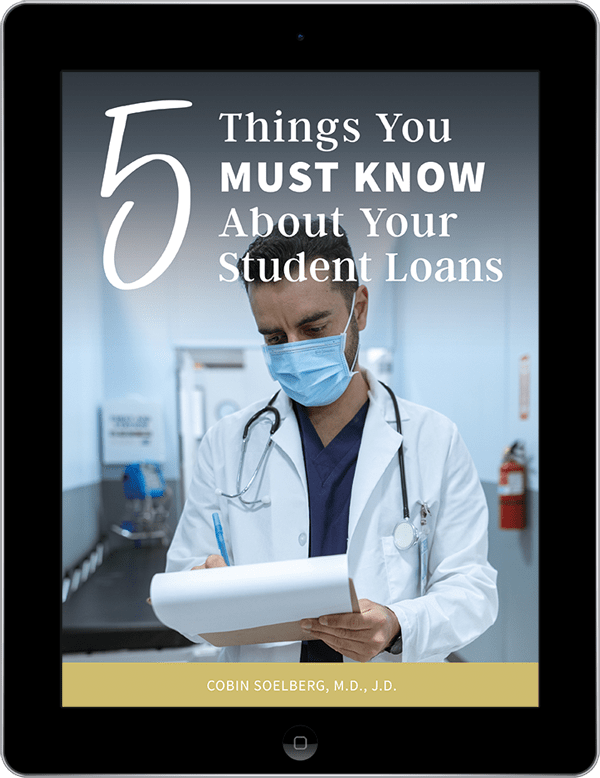There are first steps you can take as a doctor to decrease medical school debt.
#1 Know what you actually owe
Ok, so you’re a physician and you want to eliminate your student loan debt. Your first step is locating all your student loan information, as painful as it might be. For federal loans, your first stop should be Student Aid – the online repository for all of your federal student loans. Here, you will find your entire federal loan borrowing history.
For private loans, I’ve found the easiest way to see all of your loans and servicers is to pull your free credit report. You’ll see your borrowing history with auto loans, credit cards, and all of your student loans, including federal loans. Reviewing your credit report every year – remember, you can pull this file free each year – is an excellent opportunity to check for errors or inaccuracies., This is especially important if you plan to refinance your loans privately.
The last few years have seen a reprieve for federal student loan borrowers. Since March 2020, federal student loan interest has been set at 0% and paused student loan payments. Both President Trump and President Biden have extended the payment and interest freeze on multiple occasions, with President Biden most recently extending the program until May 1, 2022. So what is a physician supposed to do with their student loans these days? Does it make sense to pay them off at 0%?
#2 Decide if you plan to work for a non-profit
The next step is critical – all the more so if you are just graduating from medical school. Do you plan to work for a 501(c)(3), aka a non-profit, when you graduate? Why is this so important? If you plan to go for Public Service Loan Forgiveness (PSLF), consolidating your federal loans and starting an Income-Based Repayment (IBR) program is one of the first steps. Most academic hospitals meet the non-profit status, but you’ll want to confirm before planning on PSLF.
I will do a more in-depth piece on PSLF later, but for now, determine if you are going this route. If you ARE planning on going for PSLF, do NOT privately refinance your federal loans. You can consolidate and get on an IBR repayment schedule, but you do not want to convert your federal loans to private loans. Private loans are not eligible for PSLF.
#3 Consider if refinancing makes sense for you
Refinancing has been more challenging during the last two years, with federal student loans at 0% and the payment freeze. If that wasn’t good enough, the federal government has counted those “payments” towards PSLF. This has been a huge financial win for anyone going for PSLF, especially for young attendings with more considerable payments!
For private loans, the decision to refinance is much easier. If you can qualify for a private loan refinanced at a lower rate than you currently pay and can afford the increased payments, you’ll want to refinance. Unlike mortgage refinancing with layers of fees, most student loan refinancing does not come with associated costs. Even better, many companies offer a bonus for refinancing! As long as you can afford the payment, it almost always makes sense to refinance to a lower rate.
How to decide which lender and which refi rate to choose? Checking your credit comes as a soft pull for most student loan refinancing companies. What does that mean? Part of your credit score is how often companies have pulled your credit. It can be an indication of how much you borrow. Check with each company first. I recommend getting 3-4 different rate quotes. This will allow you to see the loan terms for which you qualify.
There are three considerations when deciding on where to refinance. First, look at the different interest rates you qualify for. I also recommend choosing between a fixed APR and a variable APR. Variable rates are almost always lower than fixed rates. If you plan to repay your loan before the variable term ends, this loan is a much better deal and will save thousands on interest. However, keep in mind that if rates go up and your circumstances change so that you don’t pay off the loans as quickly, a variable rate can come back to bite.
Your second consideration is the loan term length. Most physicians can repay their student loans within five years. In general, the shorter the length of the loan, the lower the interest rate. But… your monthly payment will be higher with a shorter term. When you know your monthly cash flow and what you can allocate to debt repayment, you can pick the right refi for your specific needs.
Finally, the student loan refi companies often offer cash bonuses for refinancing, ranging from hundreds to thousands of dollars. While your interest rate will be the most crucial factor in determining how much you end up repaying, a sign-up bonus can be nice.
It is important to mention that private companies offer less protection for partial and total disability. You or your estate will be on the hook for these loan payments. The same goes for unemployment. While many of these companies will work with you to figure out a repayment schedule, they are not required to. Private companies tend to be more aggressive in collecting these debts. This should not deter you from refinancing your loans.
#4 Start paying
Paying off your student loan debt is one of the best ways to accelerate your path to financial freedom. Once paid off, you can use this money to build your wealth rapidly. There truly is a liberating feeling once you work because you want to and not because you must. Even more is the mental weight lifted off your shoulders when you are out of debt.
This article was originally posted on DocWorking.





